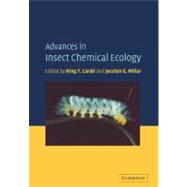
Note: Supplemental materials are not guaranteed with Rental or Used book purchases.
Purchase Benefits
Looking to rent a book? Rent Advances in Insect Chemical Ecology [ISBN: 9780521792752] for the semester, quarter, and short term or search our site for other textbooks by Edited by Ring T. Cardé , Jocelyn G. Millar. Renting a textbook can save you up to 90% from the cost of buying.
| Preface | |
| 1. Phytochemical diversity of insect defenses in tropical and temperate plant families John T. Arason, Gabriel Guillet and Tony Durst | |
| 2. Recruitment of predators and parasitoids by herbivore-injured plants Ted C. J. Turlings and Felix Wä | |
| ckers | |
| 3. Chemical ecology of astigmatid mites Yasumasa Kuwahara | |
| 4. Semiochemistry of spiders Stefan Schulz | |
| 5. Why do flowers smell? The chemical ecology of fragrance-driven pollination Robert A. Raguso | |
| 6. Sex pheromones of cockroaches Cé | |
| sar Gemeno and Coby Schal | |
| 7. A quest for alkaloids: curious relationship between tiger moths and plants containing pyrrolizidine alkaloids William E. Conner and Susan J. Weller | |
| 8. Structure of the pheromone communication channel in moths Ring T. Cardé | |
| and Kenneth F. Haynes | |
| Index. |
The New copy of this book will include any supplemental materials advertised. Please check the title of the book to determine if it should include any access cards, study guides, lab manuals, CDs, etc.
The Used, Rental and eBook copies of this book are not guaranteed to include any supplemental materials. Typically, only the book itself is included. This is true even if the title states it includes any access cards, study guides, lab manuals, CDs, etc.